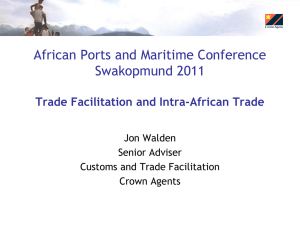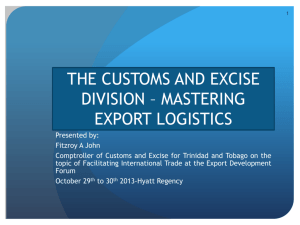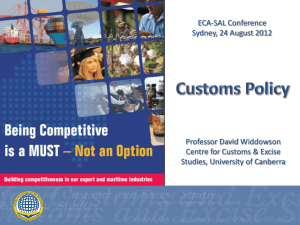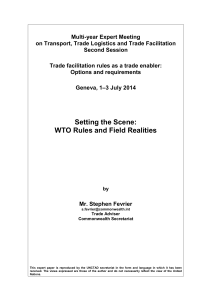Document 11312516
advertisement
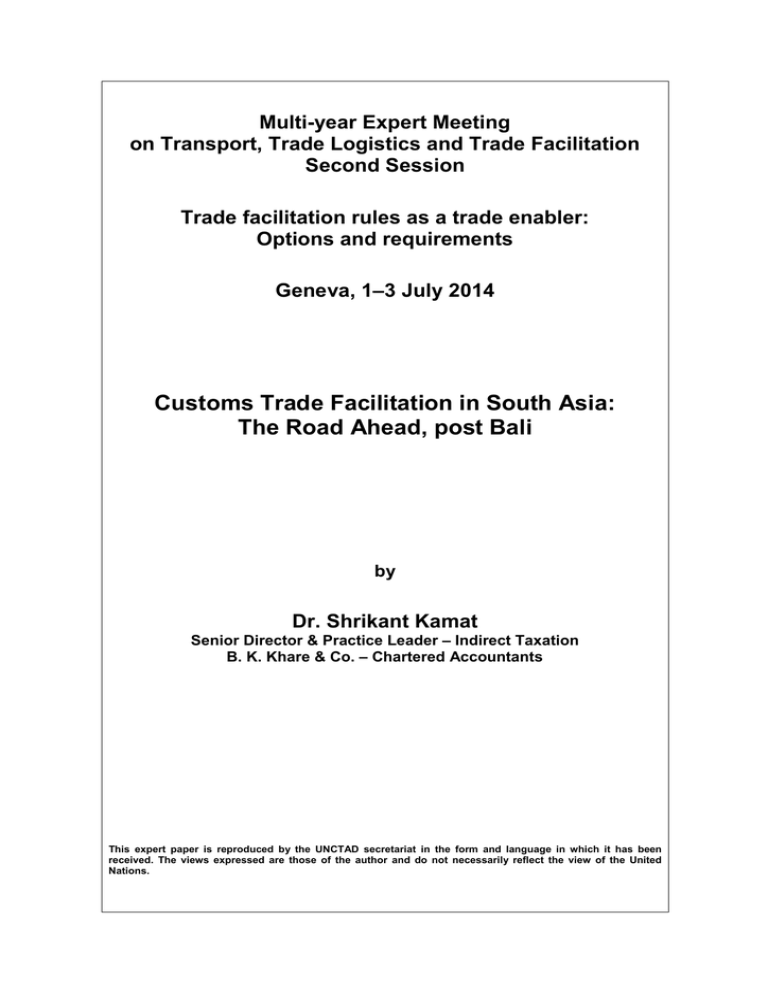
Multi-year Expert Meeting on Transport, Trade Logistics and Trade Facilitation Second Session Trade facilitation rules as a trade enabler: Options and requirements Geneva, 1–3 July 2014 Customs Trade Facilitation in South Asia: The Road Ahead, post Bali by Dr. Shrikant Kamat Senior Director & Practice Leader – Indirect Taxation B. K. Khare & Co. – Chartered Accountants This expert paper is reproduced by the UNCTAD secretariat in the form and language in which it has been received. The views expressed are those of the author and do not necessarily reflect the view of the United Nations. 7/11/2014 Customs Trade Facilitation in South Asia: The Road Ahead, post Bali Dr. Shrikant Kamat Senior Director & Practice Leader – Indirect Taxation B. K. Khare & Co. – Chartered Accountants Significance of Customs Trade Facilitation Measures which simplify trade procedures can potentially reduce Trade Transaction Costs by 5.4 percent. For developing countries, the estimated $1 trillion increase in two-way trade delivers GDP increases of $520 billion. Overall, the potential trade expansion from a far-reaching trade facilitation agreement could translate to world GDP increases of $960 billion annually. The agreement on Trade Facilitation may reduce global trade costs by 10 %-15 % through increased trade flows and revenue collection Significant improvements in trade facilitation could increase exports of developing countries by approximately $570 billion and exports of developed countries by $475 billion 1 7/11/2014 Anticipated Benefits from the TFA The TFA will seek to – • Simplify Customs - the agreement will make customs procedures smoother and easier, reducing unnecessary delays and administrative burdens. . • Eliminate Red Tape – it will increase efficiency and transparency, reduce bureaucracy and corruption. • Introduce new technology – the agreement secures the use of latest modern technologies. • Smoothen transit – This will facilitate faster movement of goods for landlocked countries seeking to trade through ports in neighbouring countries • SDT - agreement allows developing and least developed countries to choose which of its parts to implement immediately, which to delay • Offer a choice to notify commitments - Members would not be obliged to undertake investments in infrastructure projects beyond their means Trends in Trade Growth in South Asia Yearwise exports from member states under SAFTA 600'000'000.00 Source: Asian Development Bank 2014, http://aric.adb.org/integrationindicators#sthash.t79Zl1py.dpuf 500'000'000.00 400'000'000.00 300'000'000.00 200'000'000.00 100'000'000.00 0.00 2006 Afghanistan 2007 Bangladesh 2008 Bhutan 2009 India 2010 Maldives 2011 Nepal Pakistan 2012 2013 Sri Lanka 2 7/11/2014 Trends in Trade Growth in South Asia Percentage growth in South Asian Region's international trade in goods during the period 1980-84 to 2010-14 30.00 25.00 20.00 15.00 10.00 5.00 0.00 1980-84 1990-94 Growth in South Asia's imports from the world 2000-2004 2010-2014 (Estimates) Growth in South Asia's exports to the world Current Status of Trade Facilitation in South Asia Bangladesh • With the assistance of the World Bank, an alternative dispute resolution system has been introduced in 2012. The new process allows taxpayers to amicably settle their Customs disputes out of Court, using the guidance of a facilitator. • This process should help Bangladesh in reducing the long delays. stemming from an estimated 20000 case backlogs. Bhutan • Bhutan faces major delay because of tardy procedural clearances. Eg. procedural approvals for both importers and exporters to transport pulses from Nepal to Bhutan via India takes at least 23 days. • A National Trade Facilitation Committee has been constituted in February 2013. • Other important trade facilitation measures that will be implemented in the near future include the harmonization of forms; • the amendment of the existing Customs law; and • the introduction of an authorized economic operator concept, Audit based control and advance ruling. 3 7/11/2014 Current Status of Trade Facilitation in South Asia Nepal Trade is more restricted in Nepal compared to other South Asian Countries; the average customs transaction involves 20 to 30 steps, 40 documents, 200 data elements and re-keying of 60 per cent to 70 per cent of all data at least once. Pakistan Pakistan’s National Trade and Transport Facilitation has produced concrete results such as the introduction of the United Nations Layout Key based document and standardized ship clearance forms, the launch of a web based One Customs System as well as the final accession of Pakistan to several international conventions Srilanka Ranking 81st in its overall Logistics Performance Index (LPI) score, Sri Lanka is ranked higher than the average LPI score of South Asian countries. Current Status of Trade Facilitation in South Asia India • Transaction cost in imports and exports in India could be around 15 percent of the cost of goods; • Ranking at number 46, India leads the South Asian region with a LPI score of 3.08 • The dwell time studies conducted by the Customs Department indicates that in India the average time taken by import consignments for clearance is 10 days after landing, could be higher (around 12 days) • About 1% of the Bills of Entry are detained for contraventions and subjected to adjudication; almost 70% of such Bills of Entry are detained for more than 3 days. • Through the facility of ICEGATE, the Customs Department has offered a host of services including the facility of electronic filing of documents; • The Risk Management System or RMS, launched in 2005, provides for clearance of low-risk consignments without assessment or physical checking. • Other recent trade facilitation initiatives include – • • • • Post clearance audit 24x7 Clearance & Payment Container Scanning Authorised Economic Operator (AEO) scheme 4 7/11/2014 Regional Trade Facilitation in South Asia – An Update India - Bhutan • In May 2014, government officials from Bhutan and India agreed to embark on a feasibility study that will pilot UNESCAP's Secure Cross-Border Transport Model (SCBTM) along key trade corridors, aimed at speeding up and reducing the cost of trade through designated land routes and border-crossing points. • The SCBTM is designed to optimize the use of technology and institutional mechanisms that both secure transit cargo and reduce the cost and time of clearing cargo at borders. • Through its use of global positioning systems, cellular communications, geographical information systems, radio frequency identification, web-based software and others, the SCBTM is able to address the concerns of national Customs administrations and other control authorities, such as the authenticity of declarations and safety of cargo. Regional Trade Facilitation in South Asia – An Update India - Bhutan • A limited pilot run of the SCBTM from Kolkata to Thimphu via Phuenthsholing, will be conducted from 30 June to 9 July 2014. This limited pilot test will: • Brief Indian Customs officials on the elements and benefits of the SCBTM (Delhi meeting) • Flesh out the outline, data requirements, work plan and schedule of the feasibility study on the pilot application of the model, including arrangements for a trial run of the electronic vehicle tracking system (Kolkata meeting). • Brief the study team on the processing of Bhutan transit cargo in Kolkata Port (Kolkata Port Visit) • Undertake a trial run by tagging electronic seals on actual cargo en route from Kolkata to Thimphu, to gain a clearer understanding of the environment, road and electronic tracking conditions that cargo is subjected to (KolkataJaigaon-Phuentsholing-Thimphu) • Brief Bhutan customs and other officials and private stakeholders, on the objectives, scope, outputs and activities of the feasibility study, including their expected contributions to the study (Phuentsholing and Thimphu meetings). • Customs officials of Bhutan and India will participate in the pilot testing, together with private stakeholders (e.g., exporters, brokers, transporters) from both countries, staff of ADB & the UNESCAP for the region 5 7/11/2014 Regional Trade Facilitation in South Asia – An Update Srilanka • Sri Lanka Customs has initiated several programs to reduce documentation and clearance times in the trading process, such as the recent ‘Sri Lanka Customs Paperless Exports Clearance Initiative’. • Implemented since December 2013 (post Bali TFA), the number of documents in the export process under this initiative is likely to witness a decrease from the earlier 12-16 documents, to current 4-5 documents. • Some of the initiatives under this program include – • Warranting the Customs Declaration (CUSDEC) form without the paper copy being submitted to Exports Office (e-warranting is however, still at the initial stages, with few exporters using this facility) • Calculation and payment of all charges including the fee for Panel Examination will be done in one instance rather than having to make payments at different points of the process; • Establishment of Centralised Cargo Examination facility (within close proximity to the port) enables the cargo to be examined at the central facility rather than having a customs officer visit individual factories to carry out the panel examinations; and ( • Better utilisation of the Green Channel Regional Trade Facilitation in South Asia – An Update Bangladesh – Bhutan – Nepal (South Asia Sub-regional Economic Cooperation (SASEC) Trade Facilitation Programme) • This programme aims to increase trade of SASEC countries by reducing/removing non-tariff institutional, administrative, and technical barriers to trade. • It supports modern and effective customs administrations, streamlined and transparent trade processes/procedures, and improved services and information for private sector traders and investors • Being a continuous one, total cost of the programme is US$ 48 Million, which is funded by the ADB SASEC Trade Facilitation Sector Strategy • Implement the SASEC Trade Facilitation Strategic Framework 2014-2018, focusing on customs modernization, standards and conformity assessment strengthening, cross-border facilities improvement, through transport facilitation, and institution and capacity building • Support the strategic priorities of South Asia Free Trade Agreement (SAFTA) cooperation framework 6 7/11/2014 Scope of the Agreement on Trade Facilitation The TFA comprises of two sections: Section I, dealing with trade facilitation measures and obligations; and Section II dealing with Special & Differential Treatment (SDT) for developing and least developed countries Coverage of TFA Section I of the Agreement covers following areas of Trade Facilitation: Article 1: Publication and availability of information Article 2: Prior publication and consultation Article 3: Advance rulings Article 4: Appeal or review procedures Article 5: Other measures to enhance impartiality, non-discrimination and transparency Article 6: Disciplines on fees and charges imposed on or in connection with importation and exportation Article 7: Release and clearance of goods Article 8: Border agency coordination Article 9: Movement of goods under customs control intended for import Article 10: Formalities connected with importation and exportation and transit Article 11: Freedom of transit Article 12: Customs cooperation Article 1: Publication and availability of information Given that very little clarity is forthcoming on the process flow and the corresponding information requirement at each stage of such process flow on the web portals of most of the customs services in South Asia, this Article is likely to help the trade in accurate estimation of dwell time at the port. It is essential for the trade to understand the minutest requirement related to documents and information as well as the step by step process involved in getting the consignment cleared. This will be achieved to a large extent with the help of Article 1. 7 7/11/2014 Article 2: Prior publication and consultation The agreement imposes new obligations on Member States to consult traders and other interested parties prior to introducing new or amended laws or regulations related to the movement, release and clearance of goods. It also provides for regular consultations between border agencies, traders and other stakeholders within its territory. To a reasonable extent, this process of prior publication and consultation is already in place in India, Pakistan, Srilanka and Bangladesh. So it is unlikely that Article 2 would offer anything new to traders in South Asia. Article 3: Advance rulings This is a new area for WTO rules, but reflects existing practice in many - if not most - Member States in the SAARC region. However, LDCs like Bangladesh, Bhutan and Nepal will be required to eliminate uncertainty on key technical issues on Customs by putting in place, an effective Advance Ruling system. 8 7/11/2014 Article 4: Appeal or review procedures • The new agreement expands provisions on appeal or review procedures - administrative or judicial – beyond those already contained in GATT Article X. • All the SAARC member states (barring Afghanistan, for which, information in English language on the Appeal procedure, wasn’t available for verification) already have a well-structured and fair appeal and review procedure in place, so far as Customs disputes are concerned. • Hence, there will be very limited scope for any further facilitation for trade on this count. Article 6: Disciplines on fees and charges imposed on or in connection with importation & export • The aim of this article is to limit the size of fees and charges to the approximate cost of the services rendered, in keeping with existing GATT obligations. • Even though all the SAARC member nations provide, in their respective customs legislation, clarity on the maximum penalty leviable for relevant offences, there is minimal transparency in most of these laws on the basis to be applied to justify imposition of a particular quantum of penalty in a given case. • It is essential that quantitative measures are devised for imposition of penalties by Customs at any port across the SAARC Region so that the trader is well aware of the maximum penalties or cost that he is likely to incur on this account. 9 7/11/2014 Article 7: Release and clearance of goods • This article provides for adoption of best practice in customs procedures, and reflects recommendations of the WCO, notably in the Revised Kyoto Convention. • Barring, India, Pakistan and Srilanka, where already there are lot many new TF initiatives underway, other SAARC countries, being LDCs, are unlikely to initiate any new programmes barring the existing ones, as it would demand introducing new technology and consequent huge investment in infrastructure, technology and training of human resources. • In most likelihood, Article 7 may witness a plethora of cases before the WTO Dispute Settlement Body (DSB), with one or more of the South Asian Countries being the defending parties to the dispute. Article 8: Border agency coordination • This article places an obligation on Member States to ensure that its authorities and agencies responsible for border controls and procedures for import, export and transit of goods cooperate with one another and coordinate their activities in order to facilitate trade. (ITC 2013, p. 15).The article suggests that such cooperation and coordination may include: a. Alignment of working days and hours b. Alignment of procedures and formalities c. Development and sharing of common facilities d. Joint controls e. Establishment of one stop border post control • All SAARC member countries are already a part of the WCO led initiative to promote coordinated border management. However, there is not much progress accomplished on this front with multiple agencies and documentation causing significant increase in time and cost in clearance of cargo. Single Window is the solution for most of the delays 10 7/11/2014 Article 9: Movement of goods under customs control intended for import This article requires Member States, to the extent possible, to allow goods intended for import to be moved under customs control from the point of entry to another customs office. The aim of this article is to speed the flow of goods at borders and to allow goods to be cleared at inland depots. Normally this should not be a problem and indeed would help improve border clearance times in South Asia, across all Countries in the region. Article 10: Formalities connected with importation and exportation and transit This article aims at minimizing the incidence and complexity of import, export and transit formalities and at simplifying documentation. It covers: 1. Formalities and documentation requirements 2. Acceptance of copies 3. Use of international standards 4. Single window 5. Pre-shipment inspection 6. Use of customs brokers 7. Common border procedures and uniform documentary requirements 8. Rejected goods 9. Temporary admission for goods including inward/outward processing Presently, there is little commonality adopted by Customs services of respective SAARC members, more specifically in relation to uniform documentary requirements and temporary admission of goods. This provision will introduce consistency among all South Asian Customs. 11 7/11/2014 Article 11: Freedom of transit • For transit traffic, the due diligence expected of customs is limited to affixing or checking the seals and verifying the guarantee instrument. As a general rule no inspection of the goods is required. Other border agencies, such as standards or quarantine, are not parties to transit operations. • This Article will ultimately lead the way towards A carnet transit regime, or regional single procedure regime • Widely seen as the best practice for international transit regimes, the TIR system is a model for any future regional transit frameworks. • The adoption of TIR Convention by SAARC member nations will be an important step towards streamlining transit procedure in South Asia Article 12: Customs cooperation • • • • • The article sets out the procedures that Member States must follow when a customs authority needs information from the authority in another Member State to verify an import or export declaration, because of suspicions over the truth or accuracy of the declaration. Information must be held in strict confidence and not disclosed without specific written permission. There are provisions for postponement or refusal of a request, including for reasons of lack of reciprocity in meeting a similar request in the opposite direction. The article also makes clear that Member States may enter into or maintain bilateral, plurilateral or regional agreements for sharing or exchanging customs information and data. The South Asian Countries do not have as yet, a strong Customs – Customs co-operation network. The political climate of the region is largely responsible for this failure. Until this is put in place, it will be difficult to improve transit trade in the region 12 7/11/2014 Special & Differential Treatment The agreement recognizes that some Member States will require technical assistance before they can implement some or all of the obligations to which it binds them. Consequently, those commitments by developing and LDCs members will be implemented according to different categories of commitments. It will fall to each developing and LDC Member State to determine the timing and entry into force of its commitments, according to the following categories: • Category A – Immediate commitments upon entry into force of the agreement; • Category B – Deferred commitments designated for implementation on a date after a transitional period; • Category C - designated for implementation on a date after a transitional period and the acquisition of implementation capacity through the provision of technical assistance and support for capacity building. Emerging Trends in South Asia Role of National Trade Facilitation Committees Trade facilitation requires coordination: there are multiple public and private stakeholders involved, multiple control and enforcement agencies to be included and multiple laws, regulations, procedures and documents to be considered. It is imperative therefore that any measure introduced by the National Customs administration is undertaken after consultation with all the stakeholders. This can be achieved through setting up of a National Trade Facilitation Committee. A national TF committee is a forum to propose, discuss, consult and search consensus on facilitation measures between commercial parties and governmental authorities to improve international trade transactions Any issue on Trade Facilitation bottlenecks raised by other trading partners should be first taken at the level of National Trade Facilitation Committee which should try and resolve the issue under guidance from the WTO Committee on Trade Facilitation, if required. Only in the event that the National Trade Facilitation Committee fails to satisfactorily resolve the trading partner’s concern, the WTO DSB should be made available to the aggrieved member, and not otherwise. Thus, approaching the DSB should be more of an exception, than a norm, so far as disputes under the TFA are concerned, in South Asia. 13 7/11/2014 Emerging Trends in South Asia SAARC Development Fund (SDF) for implementation of Customs TF measures Though an arduous task, yet extremely worthwhile would be strategic negotiations of effective bilateral and multilateral trade and transit agreements, along with the simplification and harmonization of border procedures to facilitate trade diversification. Also, the initiatives for trade facilitation need to be focused in major intra-regional trade corridors. The establishment of the SAARC Development Fund (SDF) and other such initiatives can go a long way in funding the infrastructure deficits in the South Asian region, thereby providing a fillip to a host of other trade facilitation related activities. SDF became fully operational in 2010 and operates through three Windows, viz. social, economic and infrastructure. Emerging Trends in South Asia Addressing the National Security concerns in South Asia by adopting effective RMS • The development and implementation of strategies to mitigate supply chain security risks is complicated and frustrated by the high degree of interdependence and associated network characteristics exhibited by modern global supply chains. • Supply chain security initiatives that fail to encourage inter-agency collaboration invite the same sort of costs and inefficiencies as initiatives that ignore the commercial aspects of the supply chain. • The WCO SAFE Framework—with its government -to-business and government-to-government pillars— is considered a good example of a governance approach that is relevant and effective in the international trade and transport security environment. Its effective realization is, however, likely to take some time. • Typically, the top 1% of traders are responsible for up to 80% of total exported/ imported goods. Therefore, customs agencies in South Asia have to change their strategy from item based to operator based risk management, creating significant time savings without changing their IT infrastructure 14 7/11/2014 THANK YOU B.K. Khare & Co. Chartered Accountants 706-708, Sharda Chambers, Behind Aaikar Bhavan, New Marine Lines, Mumbai – 400020 Tel: (022) 22000607/7318/6360/6631 e-mail: shrikantkamat@bkkhareco. 15
